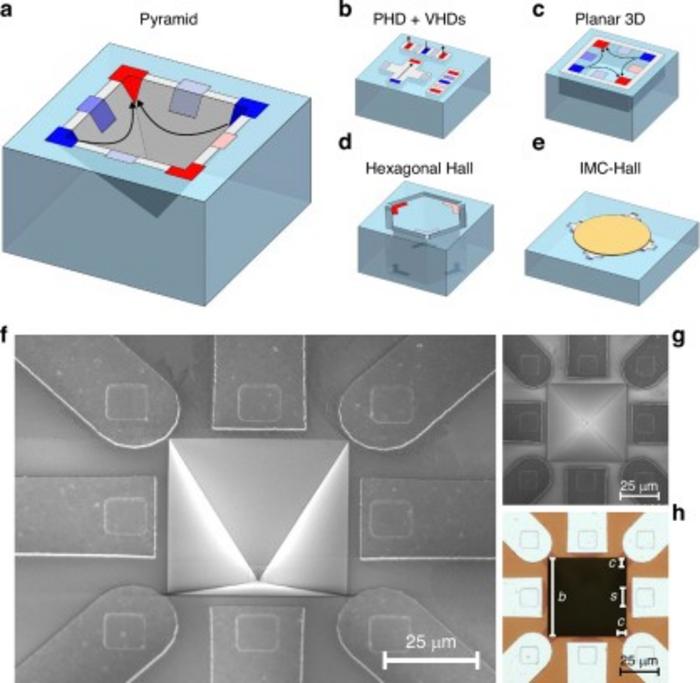A remarkable innovation in the realm of magnetic sensing technology has emerged from the research labs at Delft University of Technology. This pioneering research introduces a transformative 3-axis Hall-effect magnetic sensor that utilizes an inverted pyramid structure. This innovative design not only enhances sensitivity but also significantly mitigates offset issues, making it a key contender for various demanding applications across automotive, industrial, and consumer electronics sectors.
The quest for reliable and precise magnetic sensors has garnered significant attention over the years, particularly in industries where accurate detection of magnetic fields is crucial. Hall-effect sensors have long been the mainstay in this field. However, traditional 3-axis Hall sensors possess limitations, including suboptimal sensitivity, larger sizes, and troublesome offsets. As the industry moves towards miniaturization and heightened precision, these drawbacks become increasingly critical to address.
The groundbreaking study, published in the esteemed journal Microsystems & Nanoengineering, showcases how the novel inverted pyramid design made it possible to perform well beyond the capabilities of conventional Hall sensors. By integrating advanced micromachining techniques through micro-electromechanical systems (MEMS) alongside complementary metal-oxide-semiconductor (CMOS) processing, the researchers have fashioned a sensor capable of detecting in-plane and out-of-plane magnetic fields in a singular compact apparatus.
A crucial aspect of this development is the innovative current-spinning technique employed within the sensor. By implementing this method, the research team succeeded in reducing offsets significantly—by one to three orders of magnitude. This breakthrough addresses one of the most significant challenges facing magnetic field sensors, elevating the precision of measurements in a wide variety of settings. This advancement heralds a new era of magnetic sensing that promises to push the boundaries of technology further.
The capabilities of this new sensor are indeed impressive. With high current-related sensitivity ranging from 64.1 to 198 V A−1 T−1 and voltage-related sensitivity figures between 14.8 and 21.4 mV V−1 T−1, the sensors exhibit remarkable performance metrics. Moreover, these sensors maintain a low crosstalk rate of less than 4.7%, ensuring that readings remain accurate and reliable. This combination of features makes the device an exceptional tool for high-precision applications, from medical devices to industrial equipment.
While the advancements are notable, the researchers are aware that there is still work to be done. The residual offset in the millitesla range presents an area for further optimization. Ongoing refinements will help pinpoint any existing issues and aim to reduce offsets even more. The potential for improvements in this aspect is promising and could lead to entirely new applications in high-precision environments.
Dr. Karen M. Dowling, one of the leading figures in this research endeavor, expressed her excitement about the significance of this sensor. She highlighted how the integration of the inverted pyramid structure with current-spinning techniques represents a remarkable leap forward in magnetic sensing technology. According to Dowling, the sensor’s ability to achieve superior sensitivity and reduce offsets opens up avenues for more precise and reliable magnetic field detection.
Given its highly compact design which merges multiple sensing modes into a single construction, this sensor stands in stark contrast to existing solutions, which tend to be bulkier and less versatile. Its small footprint is critical as industries strive for more integrated electronic systems that require reliable magnetic field sensing without compromising on space or functionality. Automated systems, robotics, electric vehicles, and consumer electronics could all see transformative improvements as this technology becomes more widely available.
As further developments and refinements occur, the revolutionary potential of this 3-axis Hall-effect sensor could significantly alter the landscape of magnetic sensor technology. The integrated design could allow for a simpler adoption process within various applications, ultimately delivering enhanced functionality and performance. Such advancements will also contribute to the ongoing trend of industries seeking improvements in design efficiency, performance capabilities, and reliability in electronic systems.
The implications of this technology extend beyond just magnetic sensing; they hint at a larger movement toward smarter, more efficient technologies in our everyday devices. With the growth of smart electronics and the Internet of Things (IoT), sensors capable of providing accurate environmental data will become even more vital in ensuring optimal operation while maximizing efficiency. As these devices become smarter and more integrated, the demand for high-performance sensors like this 3-axis Hall-effect design will undoubtedly rise.
In conclusion, the groundbreaking research from Delft University of Technology signifies a monumental stride forward in magnetic sensing technology. By addressing key challenges associated with existing Hall-effect sensors, particularly regarding sensitivity and offset issues, this new sensor paves the way for more reliable applications across diverse sectors. The developmental journey has only just begun, and as enhancements and refinements continue, we may very well see this technology redefine the way magnetic sensing is approached in the future.
Subject of Research:
Article Title: Inverted pyramid 3-axis silicon Hall-effect magnetic sensor with offset cancellation
News Publication Date: 14-Feb-2025
Web References: http://dx.doi.org/10.1038/s41378-025-00876-9
References: 10.1038/s41378-025-00876-9
Image Credits: Microsystems & Nanoengineering
Keywords
Sensors, Hall-effect, magnetic sensor, microelectromechanical systems, sensitivity.
Tags: 3-axis Hall-effect sensor technologyadvanced magnetic sensing innovationsautomotive magnetic sensing applicationsCMOS processing in sensorsconsumer electronics sensing solutionsenhanced sensitivity magnetic sensorsindustrial magnetic field detectioninverted pyramid magnetic sensormicro-electromechanical systems (MEMS) sensorsminiaturization in magnetic sensingoffset mitigation in Hall sensorstransformative sensor design research





